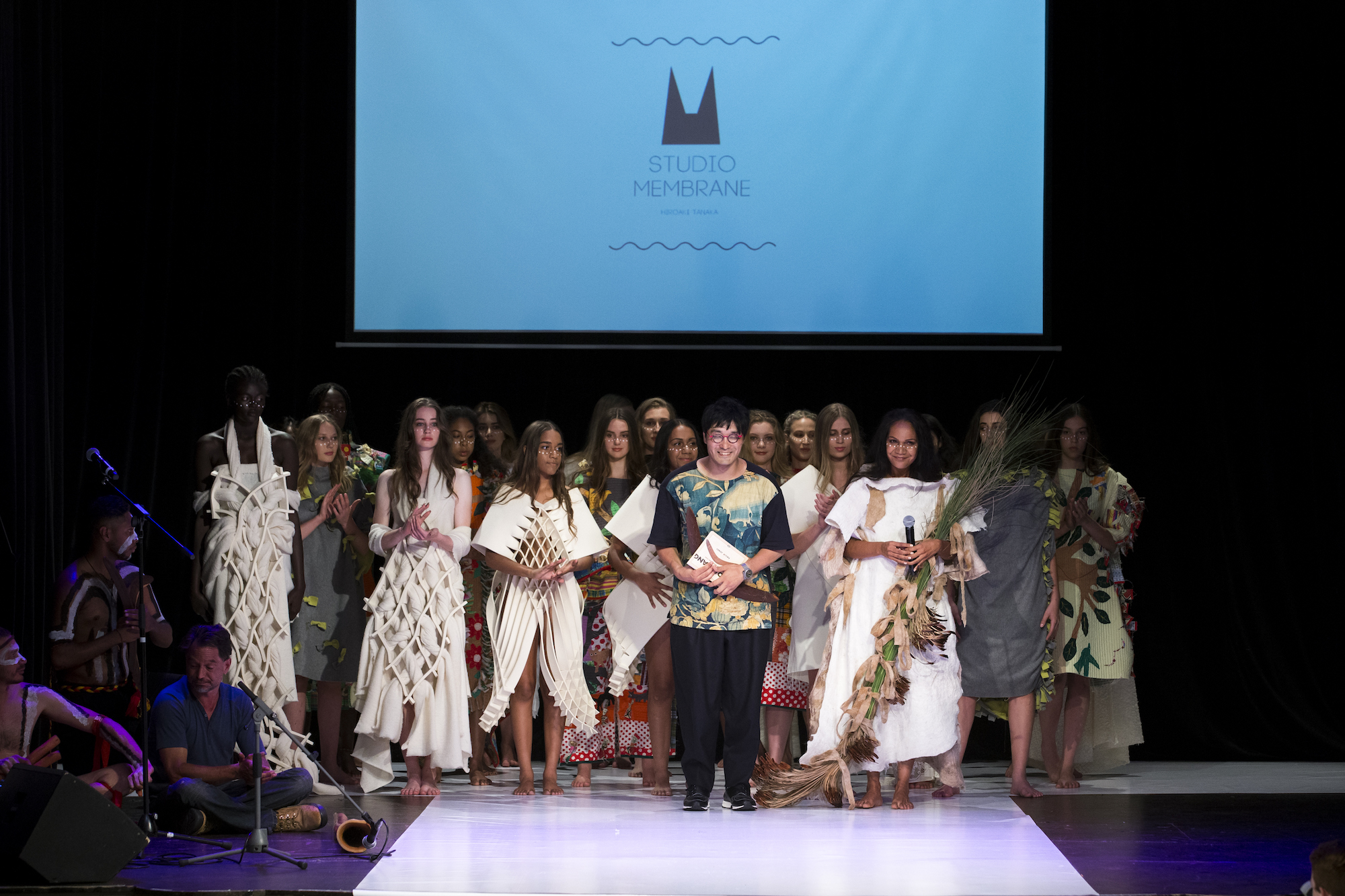FOR IMMEDIATE RELEASE (written by Robbin Whachell)
JULY 21, 2018 — Japanese designer, Hiroaki Tanaka of Studio Membrane will be returning for the second installment of Eco Fashion Week Australia in November, this time presenting textiles created by a revolutionary process of making resin from wool.
Upon doing some research the designer said he came across the work of Professor Shinji Hirai, of the Muroran Institute of Technology in Hokkaido, Japan. Hirai is also the director of the Research Center for Environmentally Friendly Materials Engineering. Hirai’s team have collaborated with Osaka-based manufacturer, Nikke (The Japan Wool Textile Co., Ltd.) exploring new possibilities in the creation of fabric made by producing ‘protein resin’ byproducts from animal waste like wool, silk and chicken feathers. This intrigued the designer and so he reached out to Professor Hirai.
“If you prepare wool cloth and compress it while also heating it, a part of the cloth becomes resin,” explains Tanaka. “This is because keratin contained in the wool becomes resin.”
His new work is called, ‘The Claws of Clothes,’ and it will unveil the result of his collaboration with Professor Hirai's laboratory developing a textile utilizing the ‘wool resin.’
Tanaka said his inspiration came from the human nail, which he says is composed of the same keratin as wool resin. “Human nails have great functionality,” he said. “Our soft fingers are equipped with hard claws. I’ve heard it said, that this may have been key to the development of mankind. Through evolution, human beings acquired delicate fingertips and managed to increase brain capacity and developed intelligence by using their hands.”
High heat and compression creates a resin textile.
“When I consider nails, which have played such a big role in our evolution, a new question was born. I wondered if clothes would change if they were equipped with claws.”
To resinify wool, the wool cloth is first prepared by removing the surface layer of cuticles which is the outer cellular layer of each fibre. Next, the cloth is stacked and compressed by heating at 100–180 °C under pressures of 20–40 MPa. In doing so, the cloth becomes resin.
“Another great feature of this is that you can dye the finished resin, and by using a method of laying fabric during the processing, you can create various facial expressions as decorations.”
“Using this technology we are also exploring ways of attaching cloth without traditional sewing. We’ve been able to plasticize or bond the fabrics by pressing them. This is exciting as it can lead to a reduction in production cost. Making the material durable against repeated washing is being addressed,” said Tanaka who said they are working on addressing the material’s durability to withstand repeat washing after such binding.
“Creating protein-based resin is advanced technology, but we have a practical use in mind, and enhanced accuracy is necessary,” said Tanaka who said research expenses are necessary to increase the precision of resinification for mass-production. As they explore new possibilities for textiles and clothing, the team is actively seeking investors with a passion for sustainability and science.
Examples of the resin textiles
“I hope to share the wonder of this research with many people,” said Tanaka.
‘The Claws of Clothes’ will be featured on the runway in both Queensland and Western Australia. First in Port Douglas when EFWA runs from Nov. 4 – 10; and again in Perth when the event runs from Nov. 15 – 21.
Eco Fashion Week Australia is proudly supported by Douglas Shire, Tourism Tropical North Queensland, Business Events Cairns & Great Barrier Reef, Eluxe Magazine, TheBahamasWeekly.com, Luxiders, Be Global Fashion Network, tommie, Olio by Marilyn, Textile Beat, Style Drama, Dowerin GWN Machinery Field Days, Loig’s Music Lab, Dene Selby Modeling Agency, Xpression Models, Claire Hair Boutique, Notre Dame University, The Beauty Room, Boos Makers, QT Port Douglas, Ethically Kate, Slow Down Style, A Small Wardrobe, ECU University, and Curtin University.
About Studio Membrane:
STUDIO MEMBRANE designs "membrane tissue," including interiors and clothes, that define a clear relationship between the body and its environments. The aim is to redefine the body as a futuristic construct. What is the body? What is a human being? I hope to find some answers to these questions. Therefore, I aim to give ambiguous expression a tangible form through product design.
www.studio-membrane.com
Contact: tanaka@studio-membrane.com
About Eco-Fashion Week Australia:
Eco-Fashion Week Australia (EFWA) began in 2017 in Perth, Western Australia and was founded by Zuhal Kuvan-Mills, artist, designer and earth ambassador for Green Embassy, Australia's first internationally recognised organic fashion label. The event draws like-minded fashion designers and speakers from around the world. In 2018 EFWA expands to two Australian states. www.ecofashionweekaustralia.com
Hiroaki Tanaka of Studio Membrane at the finale of his runway show, "Behind Useless Shape" at Eco Fashion Week Australia in 2017.




